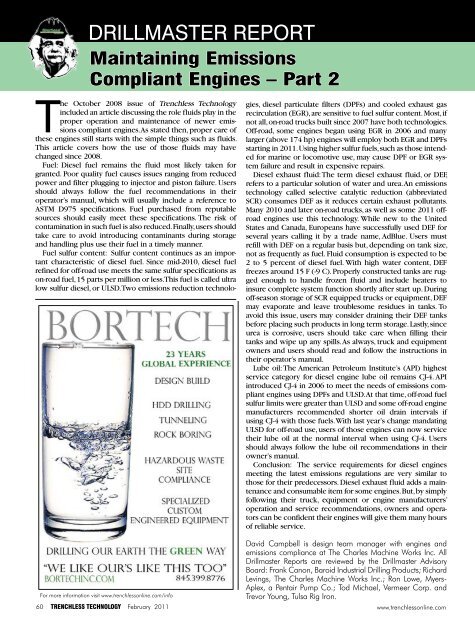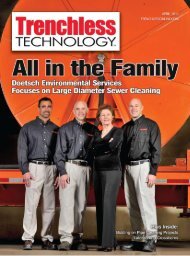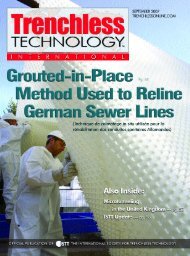Earn - TrenchlessOnline
Earn - TrenchlessOnline
Earn - TrenchlessOnline
Create successful ePaper yourself
Turn your PDF publications into a flip-book with our unique Google optimized e-Paper software.
DRILLMASTER REpoRT<br />
Maintaining Emissions<br />
Compliant Engines — Part 2<br />
The October 2008 issue of Trenchless Technology<br />
included an article discussing the role fluids play in the<br />
proper operation and maintenance of newer emissions<br />
compliant engines. As stated then, proper care of<br />
these engines still starts with the simple things such as fluids.<br />
This article covers how the use of those fluids may have<br />
changed since 2008.<br />
Fuel: Diesel fuel remains the fluid most likely taken for<br />
granted. Poor quality fuel causes issues ranging from reduced<br />
power and filter plugging to injector and piston failure. Users<br />
should always follow the fuel recommendations in their<br />
operator’s manual, which will usually include a reference to<br />
ASTM D975 specifications. Fuel purchased from reputable<br />
sources should easily meet these specifications. The risk of<br />
contamination in such fuel is also reduced. Finally, users should<br />
take care to avoid introducing contaminants during storage<br />
and handling plus use their fuel in a timely manner.<br />
Fuel sulfur content: Sulfur content continues as an important<br />
characteristic of diesel fuel. Since mid-2010, diesel fuel<br />
refined for off-road use meets the same sulfur specifications as<br />
on-road fuel, 15 parts per million or less. This fuel is called ultra<br />
low sulfur diesel, or ULSD. Two emissions reduction technolo-<br />
For more information visit www.trenchlessonline.com/info<br />
gies, diesel particulate filters (DPFs) and cooled exhaust gas<br />
recirculation (EGR), are sensitive to fuel sulfur content. Most, if<br />
not all, on-road trucks built since 2007 have both technologies.<br />
Off-road, some engines began using EGR in 2006 and many<br />
larger (above 174 hp) engines will employ both EGR and DPFs<br />
starting in 2011. Using higher sulfur fuels, such as those intended<br />
for marine or locomotive use, may cause DPF or EGR system<br />
failure and result in expensive repairs.<br />
Diesel exhaust fluid: The term diesel exhaust fluid, or DEF,<br />
refers to a particular solution of water and urea. An emissions<br />
technology called selective catalytic reduction (abbreviated<br />
SCR) consumes DEF as it reduces certain exhaust pollutants.<br />
Many 2010 and later on-road trucks, as well as some 2011 offroad<br />
engines use this technology. While new to the United<br />
States and Canada, Europeans have successfully used DEF for<br />
several years calling it by a trade name, AdBlue. Users must<br />
refill with DEF on a regular basis but, depending on tank size,<br />
not as frequently as fuel. Fluid consumption is expected to be<br />
2 to 5 percent of diesel fuel. With high water content, DEF<br />
freezes around 15 F (-9 C). Properly constructed tanks are rugged<br />
enough to handle frozen fluid and include heaters to<br />
insure complete system function shortly after start up. During<br />
off-season storage of SCR equipped trucks or equipment, DEF<br />
may evaporate and leave troublesome residues in tanks. To<br />
avoid this issue, users may consider draining their DEF tanks<br />
before placing such products in long term storage. Lastly, since<br />
urea is corrosive, users should take care when filling their<br />
tanks and wipe up any spills. As always, truck and equipment<br />
owners and users should read and follow the instructions in<br />
their operator’s manual.<br />
Lube oil: The American Petroleum Institute’s (API) highest<br />
service category for diesel engine lube oil remains CJ-4. API<br />
introduced CJ-4 in 2006 to meet the needs of emissions compliant<br />
engines using DPFs and ULSD. At that time, off-road fuel<br />
sulfur limits were greater than ULSD and some off-road engine<br />
manufacturers recommended shorter oil drain intervals if<br />
using CJ-4 with those fuels. With last year’s change mandating<br />
ULSD for off-road use, users of those engines can now service<br />
their lube oil at the normal interval when using CJ-4. Users<br />
should always follow the lube oil recommendations in their<br />
owner’s manual.<br />
Conclusion: The service requirements for diesel engines<br />
meeting the latest emissions regulations are very similar to<br />
those for their predecessors. Diesel exhaust fluid adds a maintenance<br />
and consumable item for some engines. But, by simply<br />
following their truck, equipment or engine manufacturers’<br />
operation and service recommendations, owners and operators<br />
can be confident their engines will give them many hours<br />
of reliable service.<br />
David Campbell is design team manager with engines and<br />
emissions compliance at The Charles Machine Works Inc. All<br />
Drillmaster Reports are reviewed by the Drillmaster Advisory<br />
Board: Frank Canon, Baroid Industrial Drilling Products; Richard<br />
Levings, The Charles Machine Works Inc.; Ron Lowe, Myers-<br />
Aplex, a Pentair Pump Co.; Tod Michael, Vermeer Corp. and<br />
Trevor Young, Tulsa Rig Iron.<br />
60 TRENCHLESS TECHNOLOGY February 2011 www.trenchlessonline.com








